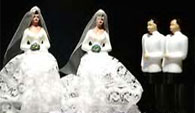Nepal's Blue Diamond Society and Western media have described the event in Nepal as a 'same-sex' wedding, without comment on the bride's attire. (Click here to read related story) When the news magazine India Today deals with homosexuality, it shows men dressed in saris. Newspapers in Bangkok, where I live, constantly equate gay men with transgender kathoey.

I can recall the struggle in the West in the 1960s by gay men to avoid the stereotype that we were all drag queens. I visited Amsterdam in 1968 and was impressed at the lack of drag. There were a couple of effeminate lady-boys - both from Asia. Oh, I said to myself, drag is a reaction to oppression. No oppression = no drag. That's what I said then.
Gays in the West successfully shook off the image of effeminacy. All the guys cut their hair, bought leather vests and worked out in the gym. The new butch image became famous as the "Castro clone." It is still the western porn star image, where two muscular guys take equal turns at insertion. No lady-boys at Falcon or Colt.
Metrosexual came much later, when both gays and straight men softened up. But the current Thai movie of the same name, sees fags hiding behind the metrosexual image.
As a number of Western writers have suggested, there are three general models for same-sex relationships - age stratified, gendered and egalitarian.
Age-Stratified:
The accounts we have of classical Greece tell of age-stratified relationships. A mature man becomes the mentor, patron, guide for a slight young guy. While not all of these relationships may have been sexual, many certainly were. When the young man matures he assumes his own role as a husband and father - and perhaps, as well, the mentor for a younger man.
Is he "gay"? Is he "bisexual"? The terms, as we understand them, don't work very well.
More recently anthropologists gave us accounts of Melanesian patterns that fit none of our preconceptions. Young men, it was said, needed semen to help them mature. In some tribes they got semen from mature men orally. In other cases, the mature man spread his semen on the body of the younger man.
Was this even "sex"? As in classical Greece, the young man went on to become a husband and father. Probably he assisted a new generation of young men in their development.
The modern image of the 'age-stratified' relationship is the 'sugar daddy' and the 'boy', the latter often smaller, younger and more effeminate - though probably these days, a hunk with muscles. Muscles sell.
Gendered:
In a gendered relationship, one partner is masculine and the other feminine. The 'tom-dee' pattern in Thailand is a familiar example. The tom is the active partner. The dee, she suspects, is really heterosexual, and the tom fears loosing her to a biological man.
The bakla in the Philippines, it is said, wants a "real" man. She must support her lay-about husband, to keep him close to her. She is feminine, but also the breadwinner.
In many places, the macho / top / king is not stigmatised as gay. It is the fem / bottom / queen who bears the label of deviance. The distinction is a big deal.
Egalitarian:
In the West, these days, heterosexual relationships are increasingly egalitarian. You can't easily identify lesbians any more. All women have what used to be lesbian haircuts. They are more practical for wives who work outside the home. Two-income households are now the norm. Pantsuits are acceptable business wear for women. The Dolly Parton big-hair look is a throwback.
Contrast India. Women all have long hair and wear strictly gendered clothing (except for the occasional butch).
In the West heterosexual relationships are much less gendered. The sexual division of labor makes little sense in a modern urban economy, and it is going the way of big hair. These changes are slow to take place - and have begun in Asia.
In the West the model for same-sex relationships now is egalitarian. Images of age-stratified or gendered relationships are somewhat embarrassing - and never show up in magazines like Gay Times or The Advocate. Or on the cover of The Economist.
But make no mistake. I give warm wishes to the couple in Nepal. A gendered same-sex relationship may be much easier for them in contemporary Nepal than other options. Not options, of course. We still largely live within the guidelines set by our own home cultures.
Douglas Sanders is a retired Canadian law professor living in Bangkok. He can be contacted at sanders_gwb@yahoo.ca.
